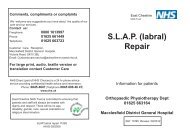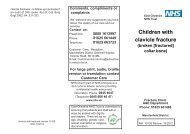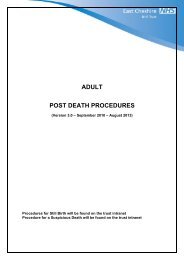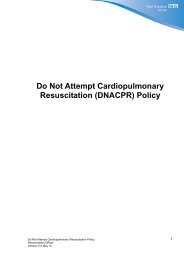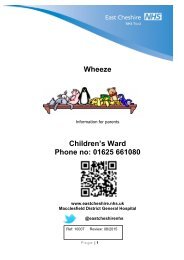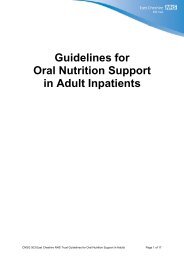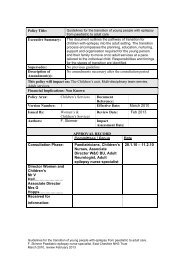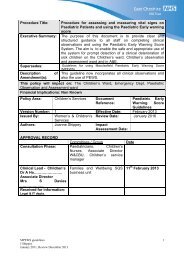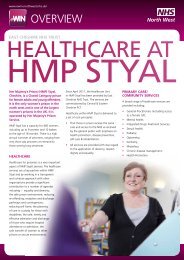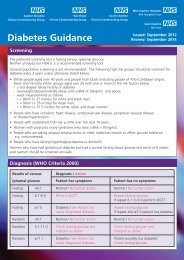The aims and expected benefits of providing the children's ...
The aims and expected benefits of providing the children's ...
The aims and expected benefits of providing the children's ...
You also want an ePaper? Increase the reach of your titles
YUMPU automatically turns print PDFs into web optimized ePapers that Google loves.
Policy Title:Guidelines for Children’s Community teamOperational PolicyExecutive Summary: <strong>The</strong> <strong>aims</strong> <strong>and</strong> <strong>expected</strong> <strong>benefits</strong> <strong>of</strong> <strong>providing</strong> <strong>the</strong> children’scommunity nursing service are; to reduce <strong>the</strong> number <strong>of</strong>children admitted to hospital, reduce <strong>the</strong> length <strong>of</strong> in-patientstay when admission is unavoidable, <strong>and</strong> promote child <strong>and</strong>family satisfaction with <strong>children's</strong> health services as a whole.This policy sets out <strong>the</strong> criteria required for admission to <strong>the</strong>service <strong>and</strong> it clarifies who holds responsibility for <strong>the</strong> childwhilst <strong>the</strong>y are a patient <strong>of</strong> <strong>the</strong> CCNT.Supersedes: Hospital at Home Operational Policy 2005Description <strong>of</strong>Amendment(s):This policy has been updated <strong>and</strong> amended taking into accountcomments obtained throughout <strong>the</strong> consultation.This policy will impact on: <strong>The</strong> Children’s Ward, CCNTFinancial Implications: Non KnownPolicy Area: Children’s Services DocumentReference:Version Number: 1 Effective Date: November 2009Issued By:Authors:Women’s & Children’sServicesReview Date: October 2012Impact AssessmentDate:Consultation Phase:APPROVAL RECORDCommittees / GroupPaediatricians, Children’s Nurses,Modern Matron / CNM –Paediatrics, Associate DirectorW&CBU, A&E ConsultantDate4/11/09 – 11/11/09Director Women <strong>and</strong>Children’sMr V Hall…………………..Associate DirectorMrs G Hopps……………….Received for information:Children’s Community TeamOperational Policy CA 2009-10-15Review 20121
Children’s Community teamOperational PolicyIntroduction<strong>The</strong> Children’s Community Nursing (CCN) Team provides family centred,acute/chronic nursing care in <strong>the</strong> child's own homeAlthough <strong>the</strong> majority <strong>of</strong> families prefer home-based care, <strong>the</strong> psychological,sociological <strong>and</strong> economic reasons why families may prefer hospital admission arenot underestimated <strong>and</strong> <strong>the</strong> <strong>the</strong>me <strong>of</strong> supportive collaboration underpins <strong>the</strong>philosophy <strong>of</strong> <strong>the</strong> CCN Service.<strong>The</strong> <strong>aims</strong> <strong>and</strong> <strong>expected</strong> <strong>benefits</strong> <strong>of</strong> <strong>the</strong> service are; to reduce <strong>the</strong> number <strong>of</strong> children admitted to hospital reduce <strong>the</strong> length <strong>of</strong> in-patient stay when admission is unavoidable promote child <strong>and</strong> family satisfaction with <strong>children's</strong> health services as a wholeAlthough <strong>the</strong> majority <strong>of</strong> families prefer home-based care <strong>the</strong> psychological,sociological <strong>and</strong> economic reasons why families may prefer hospital admission arenot underestimated <strong>and</strong> <strong>the</strong> <strong>the</strong>me <strong>of</strong> supportive collaboration underpins <strong>the</strong>philosophy <strong>of</strong> <strong>the</strong> CCN Service.Service Accommodation <strong>and</strong> Management<strong>The</strong> CCN team's <strong>of</strong>fice is located on <strong>the</strong> Children's Unit. Members <strong>of</strong> <strong>the</strong> team reportto <strong>and</strong> obtain <strong>the</strong>ir work allocation from this <strong>of</strong>fice on a daily basis.<strong>The</strong> team has one master diary in which all planned visits <strong>and</strong> phone calls arerecorded, this diary is utilised to record data <strong>of</strong> daily activity.All relevant admission details <strong>and</strong> nursing records are filed <strong>and</strong> stored securely in this<strong>of</strong>fice <strong>and</strong> are filed accordingly in <strong>the</strong> patients medical notes at <strong>the</strong> end <strong>of</strong> <strong>the</strong> episode<strong>of</strong> illness. (See Guidelines on Notes storage)Members <strong>of</strong> <strong>the</strong> CCN team report directly to <strong>the</strong> Clinical Manager - Children'sServices who in turn reports to <strong>the</strong> Clinical Lead for Paediatrics <strong>and</strong> <strong>the</strong> AssociateDirector, Women <strong>and</strong> Children's Business Unit.<strong>The</strong> day to day management <strong>of</strong> <strong>the</strong> team's caseload is <strong>the</strong> responsibility <strong>of</strong> <strong>the</strong>Children’s Community Team Leader.Children’s Community TeamOperational Policy CA 2009-10-15Review 20122
Nursing visits are planned between <strong>the</strong> hours <strong>of</strong> 07:30 <strong>and</strong> 20:00. Visits are plannedaccording to clinical need, to a maximum <strong>of</strong> three per day / per patient. Nurses willundertake approximately 6 – 10 visits per shift depending on <strong>the</strong> nursing workload<strong>and</strong> patient dependency.During operational hours nursing staff are available via mobile phone <strong>and</strong> <strong>of</strong>ficephone contact for parents. Parents are also given <strong>the</strong> inpatient unit's contact detailsshould <strong>the</strong>y need to seek help or advice outside <strong>the</strong>se hours.All staff adhere to <strong>the</strong> ECT Lone Worker policy <strong>and</strong> are provided with panic alarmsalong with a mobile phone. Community staff contact <strong>the</strong> <strong>children's</strong> ward at <strong>the</strong> end <strong>of</strong>each shift <strong>and</strong> it is <strong>the</strong> responsibility <strong>of</strong> <strong>the</strong> night staff to ensure that <strong>the</strong> communitystaff has phoned to say <strong>the</strong>y arrived home safely at <strong>the</strong> end <strong>of</strong> <strong>the</strong>ir shift.Due to <strong>the</strong> nature <strong>of</strong> <strong>the</strong> service team members in main work independently inpatients homes Clinical Supervision is available <strong>and</strong> should be accessed on amonthly basis as a minimum.Safeguarding supervision is available on an as needed basis for all members <strong>of</strong> <strong>the</strong>community team. <strong>The</strong> team leader should meet with <strong>the</strong> Named Nurse forSafeguarding Children at least three monthly for Safeguarding SupervisionAdmission CriteriaChildren can be admitted under <strong>the</strong> care <strong>of</strong> <strong>the</strong> CCN team after being an inpatient on<strong>the</strong> children’s unit if:- Home based care is appropriate for <strong>the</strong> child’s condition- A Consultant or relevant middle grade doctor has examined <strong>the</strong>child <strong>and</strong> documented <strong>the</strong> plan <strong>of</strong> care in <strong>the</strong> integrated medicalnotes- A member <strong>of</strong> <strong>the</strong> CCN team has carried out a nursing assessment<strong>of</strong> <strong>the</strong> child <strong>and</strong> agrees that <strong>the</strong> plan <strong>of</strong> care is appropriate for homenursing.- At discharge <strong>the</strong> child's clinical condition meets <strong>the</strong> relevantdischarge criteria (see Appendix 2).- Adequate visiting time is available to complete <strong>the</strong> prescribed plan<strong>of</strong> care.- <strong>The</strong> child's GP is informed <strong>of</strong> <strong>the</strong> transfer <strong>of</strong> care.Once care has been transferred to <strong>the</strong> CCN team from <strong>the</strong> children’s unit:- <strong>The</strong> Consultant Paediatrician retains overall clinical responsibility forchildren whose care has been transferred to <strong>the</strong> CCN team.- Electronic monitoring equipment <strong>and</strong> consumables will be providedby <strong>the</strong> Children's Unit, Consumables will ei<strong>the</strong>r be provided throughGP prescription or from <strong>the</strong> CCNT budget as appropriate.Children’s Community TeamOperational Policy CA 2009-10-15Review 20123
- Referrals to relevant Allied Healthcare Pr<strong>of</strong>essionals/SpecialistNurses <strong>and</strong> o<strong>the</strong>r community services will be made as appropriateby <strong>the</strong> CCN.- All patients receiving care from <strong>the</strong> CCN team will have OpenAccess to <strong>the</strong> Children's Unit <strong>and</strong> direct access to a paediatrician.- All in- patient referrals receiving input from <strong>the</strong> CCN team wouldhave open access to <strong>the</strong> children’s Unit <strong>and</strong> direct access to aPaediatrician.- If <strong>the</strong> need for medical attention is urgent <strong>the</strong> CCN has <strong>the</strong> right toarrange admission to <strong>the</strong> ward directly.-Under no circumstances will staff transport patients in <strong>the</strong>ir own cars.DocumentationA comprehensive plan <strong>of</strong> care will be discussed <strong>and</strong> agreed with <strong>the</strong> medical staff<strong>and</strong> family prior to transfer home. This plan <strong>of</strong> care will be evaluated at regularintervals <strong>and</strong> amended as required.A written nursing evaluation <strong>and</strong> record <strong>of</strong> care will be completed at each visit. This,along with any clinical observations, will be recorded in <strong>the</strong> CCN care record. <strong>The</strong>nursing care record will be filed <strong>and</strong> securely stored in <strong>the</strong> CCN team <strong>of</strong>fice whilst <strong>the</strong>child is receiving care from <strong>the</strong> CCN team. (See notes storage guidelines).A CCN information booklet with contact details <strong>and</strong> times <strong>of</strong> arranged visits will be leftat <strong>the</strong> child's home; parents are encouraged to write notes <strong>and</strong> observations to aid<strong>the</strong> CCN team in evaluating <strong>the</strong>ir child's progress.An up to date reference list <strong>of</strong> all patients receiving input from <strong>the</strong> team will be kepton <strong>the</strong> Children's Unit.Discharge from <strong>the</strong> CCN serviceNursing visits will continue until <strong>the</strong> prescribed plan <strong>of</strong> care is complete. At this point<strong>the</strong> member <strong>of</strong> <strong>the</strong> CCN team directly responsible for <strong>the</strong> child's care will:- Complete a discharge summary <strong>and</strong> distribute accordingly.- Inform <strong>the</strong> relevant Consultant Paediatrician <strong>of</strong> <strong>the</strong> discharge.- Inform <strong>the</strong> child's GP <strong>of</strong> <strong>the</strong> discharge.- Inform <strong>the</strong> Health Visitor / School Nurse as appropriate.- Ensure that any planned outpatient follow up is arranged.- Ensure that all documentation is filed appropriately in <strong>the</strong> child’smedical records.- Return <strong>the</strong> medical notes to <strong>the</strong> Children's Unit ward clerk fordischarge.Children’s Community TeamOperational Policy CA 2009-10-15Review 20124
Appendix 1MedicalAcute conditions e.g. IV antibiotics,D&V, dehydration <strong>and</strong> pyrexia.Endocrine conditions.Asthma, o2 dependentchildren,neonate, feeding issuesDiabetes ViralGeneralSurgeryHernia repairOrchidopexyAppendicectomyCircumcision, Wound CareDay Surgery follow-upOrthopaedicsExternal fixationPer<strong>the</strong>s diseaseComplexneedsTrachestomy careGastrostomy careOxygen dependentTertiaryCareOncologyCystic FibrosisRheumatologyCardiologyGastroenterologyDermotologyAtopic EczemaAllergy testingPsoriasisOpthalmologyAdministration <strong>of</strong> eye dropsFollow up <strong>of</strong> day surgeryChildren’s Community TeamOperational Policy CA 2009-10-15Review 20126
Appendix 2 CCN Team Clinical GuidelinesClinical GuidelineDischarge Criteria Viral or bacterial infection Focus <strong>of</strong> infection identified <strong>and</strong> documented. No rash evident on referral. Less than 5% dehydrated. Tolerating a minimum <strong>of</strong> 10ml/kg/hr. Have shown evidence <strong>of</strong> urine output. Parents are competent at giving medication.Clinical GuidelineDischarge Criteria Gastroenteritis Child must be less than 5% dehydrated. Be tolerating a minimum <strong>of</strong> 10ml/kg/hr. Have shown some evidence <strong>of</strong> urine output.Clinical Guideline Asthma or viral associatedwheezeDischarge Criteria A diagnosis is established <strong>and</strong> documented in <strong>the</strong> relevantnotes. Clinical observations must be stable post broncodilator(i.e. respiration rate within normal limits for age. Tolerating fluids. Parents <strong>and</strong> child educated in <strong>the</strong> use <strong>of</strong> inhalers (<strong>and</strong>accompanying devices) <strong>and</strong> deemed competent in <strong>the</strong>iruse. Information (verbal <strong>and</strong> written) on <strong>the</strong> effects <strong>of</strong> secondh<strong>and</strong> smoke given to parents.Clinical Guideline Intravenous Antibiotic <strong>The</strong>rapy(IVAB)Discharge Criteria Focus <strong>of</strong> infection identified <strong>and</strong> documented Clinical observations must be stable for a minimum <strong>of</strong> 4hours prior to discharge) All known allergies documented. Appropriate intravenous access is established prior todischarge (e.g. peripheral cannula, peripheral long line,central line, portocath) Intravenous antibiotic <strong>the</strong>rapy (type, frequency <strong>and</strong> duration)<strong>and</strong> anaphylaxis drugs are prescribed prior to discharge. <strong>The</strong> first dose <strong>of</strong> antibiotic <strong>the</strong>rapy regime is given on <strong>the</strong>Children’s Unit- any adverse reactions are documented <strong>and</strong>changes to <strong>the</strong> regime made as indicated. Antipyretic <strong>the</strong>rapy should have been commenced <strong>and</strong> beeffective. Up to three nursing visits per day Parents are given written instructions on how to care for <strong>the</strong>device used for intravenous access prior to dischargeChildren’s Community TeamOperational Policy CA 2009-10-15Review 20127
Appendix 3 Clinical CompetenciesNursing grade Skills <strong>and</strong> Competencies Qualification / LevelB<strong>and</strong> 6 Children's Nursing Qualification. RSCN / RN - child / relevant 1 st leveldegree Specialist Practitioner Children’sCommunity Nursing 1 St Level DegreeChild protection training.VenepunctureIV antibiotic administration viaperipheral <strong>and</strong> central lines Level 3Administration <strong>of</strong> cytotoxic drugsWound dressingsPaediatric Life SupportMentorship <strong>and</strong> assessingClinical supervisionAPLS Level 3B<strong>and</strong> 5 Children's Nursing Qualification.RSCN / RN - child / relevantChild protection training.VenepunctureIV antibiotic administration viaperipheral <strong>and</strong> central linesAdministration <strong>of</strong> cytotoxic drugsWound dressings Level 2Paediatric Life SupportPLSMentorship <strong>and</strong> assessingClinical supervision Level 3Appendix 2 –Equality <strong>and</strong> Human Rights Policy Screening ToolChildren’s Community TeamOperational Policy CA 2009-10-15Review 20128
Policy Title: Children’s Community team Operational PolicyDirectorate: Women & Children’sBusiness UnitName <strong>of</strong> person/s auditing / authoring policy: Sr Claire AndrewsPolicy Content:For each <strong>of</strong> <strong>the</strong> following check whe<strong>the</strong>r <strong>the</strong> policy under consideration is sensitive to people <strong>of</strong> adifferent age, ethnicity, gender, disability, religion or belief, <strong>and</strong> sexual orientation?<strong>The</strong> checklist below will help you to identify any strengths <strong>and</strong> weaknesses <strong>of</strong> <strong>the</strong> policy <strong>and</strong> tocheck whe<strong>the</strong>r it is compliant with equality legislation.1. Check for DIRECT discrimination against any minority group <strong>of</strong> PATIENTS:Question: Does <strong>the</strong> policy contain any statements whichmay disadvantage people from <strong>the</strong> following groups?ResponseActionrequiredResourceimplicationYes No Yes No Yes No1.0 Age? X1.1 Gender (Male, Female <strong>and</strong> Transsexual)? X1.2 Learning Difficulties / Disability or CognitiveXImpairment?1.3 Mental Health Need? X1.4 Sensory Impairment? X1.5 Physical Disability? X1.6 Race or Ethnicity? X1.7 Religious Belief? X1.8 Sexual Orientation? x2. Check for DIRECT discrimination against any minority group relating to EMPLOYEES:Question: Does <strong>the</strong> policy contain any statements whichmay disadvantage employees or potential employees fromany <strong>of</strong> <strong>the</strong> following groups?ResponseActionrequiredResourceimplicationYes No Yes No Yes No2.0 Age? X2.1 Gender (Male, Female <strong>and</strong> Transsexual)? X2.2 Learning Difficulties / Disability or CognitiveXImpairment?2.3 Mental Health Need? X2.4 Sensory Impairment? X2.5 Physical Disability? X2.6 Race or Ethnicity? X2.7 Religious Belief? x2.8 Sexual Orientation? xTOTAL NUMBER OF ITEMS ANSWERED ‘YES’ INDICATING DIRECT DISCRIMINATION = 0Children’s Community TeamOperational Policy CA 2009-10-15Review 20129
3. Check for INDIRECT discrimination against any minority group <strong>of</strong> PATIENTS:ActionQuestion: Does <strong>the</strong> policy contain any conditions or Responserequired Resourcerequirements which are applied equally to everyone, butimplicationdisadvantage particular people because <strong>the</strong>y cannotcomply due to: Yes No Yes No Yes No3.0 Age? X3.1 Gender (Male, Female <strong>and</strong> Transsexual)? X3.2 Learning Difficulties / Disability or CognitiveXImpairment?3.3 Mental Health Need? X3.4 Sensory Impairment? X3.5 Physical Disability? X3.6 Race or Ethnicity? X3.7 Religious, Spiritual belief (including o<strong>the</strong>r belief)? X3.8 Sexual Orientation? X4. Check for INDIRECT discrimination against any minority group relating to EMPLOYEES:Question: Does <strong>the</strong> policy contain any statements whichmay disadvantage employees or potential employees fromany <strong>of</strong> <strong>the</strong> following groups?ResponseActionrequiredResourceimplicationYes No Yes No Yes No4.0 Age? X4.1 Gender (Male, Female <strong>and</strong> Transsexual)? X4.2 Learning Difficulties / Disability or CognitiveXImpairment?4.3 Mental Health Need? X4.4 Sensory Impairment? X4.5 Physical Disability? X4.6 Race or Ethnicity? X4.7 Religious, Spiritual belief (including o<strong>the</strong>r belief)? X4.8 Sexual Orientation? XTOTAL NUMBER OF ITEMS ANSWERED ‘YES’ INDICATING INDIRECT DISCRIMINATION = 0Signatures <strong>of</strong> authors / auditors: Date: 17/11/09Equality <strong>and</strong> Human Rights Compliance / Percentage CalculationNumber <strong>of</strong> ‘Yes’ answers for DIRECT discrimination. 0Number <strong>of</strong> ‘Yes’ for INDIRECT discrimination. 0Total answers for POLICY CONTENTS discrimination. 0Percentage content non compliant 0Children’s Community TeamOperational Policy CA 2009-10-15Review 201210





